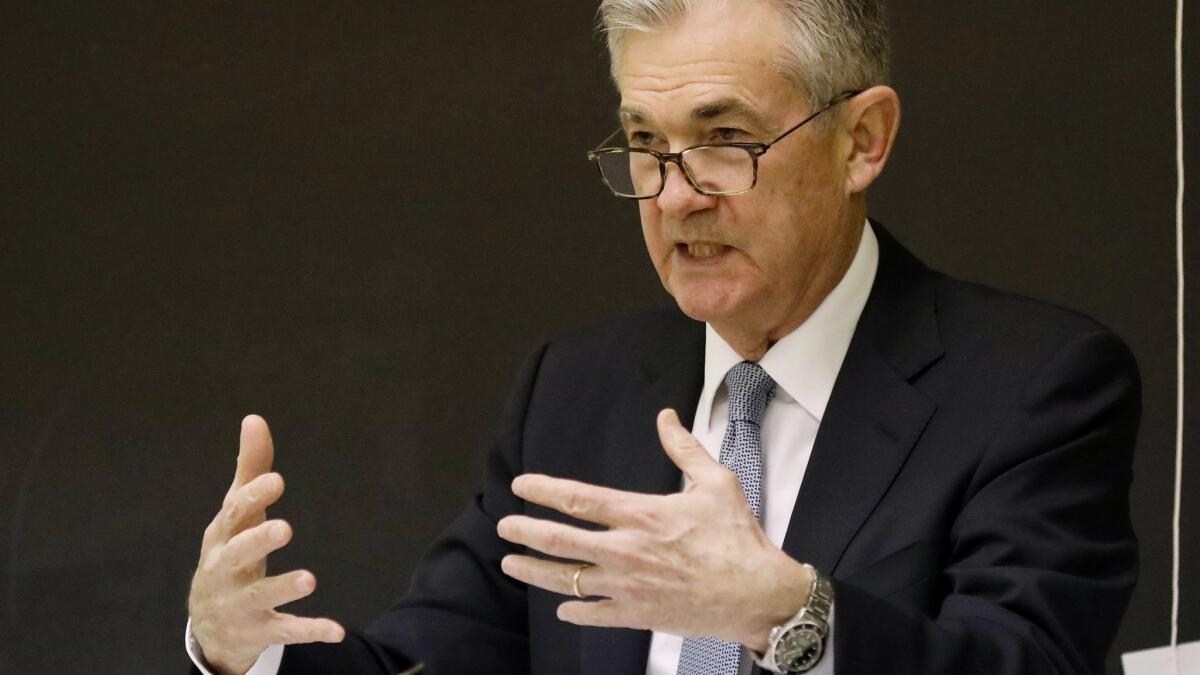Worried about a slowing economy, Fed officials want to maintain a key stimulus program

- Share via
Reporting from Washington — Amid growing worries about a slowing economy, Federal Reserve officials indicated at their meeting last month that they plan later this year to stop paring back a key stimulus program put in place in the wake of the Great Recession, according to minutes released Wednesday.
Under the controversial initiative, known as quantitative easing, the Fed purchased trillions of dollars of Treasury bonds and mortgage-backed securities from 2008 to 2014. The purchases helped push down mortgage and other long-term interest rates to encourage spending and investing over saving.
Since 2017, the Fed has been slowly reducing those asset holdings, which at a high point totaled $4.5 trillion.
But with economic growth slowing and the Fed saying last month it planned to be patient about future interest rate increases, the asset holdings were a key topic of discussion at the Jan. 29 to 30 meeting.
“Almost all participants thought that it would be desirable to announce before too long a plan to stop reducing the Federal Reserve’s asset holdings later this year,” the minutes said. “Such an announcement would provide more certainty about the process for completing the normalization of the size of the Federal Reserve’s balance sheet.”
Major U.S. stock indexes were volatile after the minutes were released but stabilized and closed roughly where they were before the news. The Dow Jones industrial average finished up 63.12 points, or 0.2%, to 25,954.44.
The Fed normally tries to stimulate or slow the economy by changing its benchmark short-term interest rate. But the Great Recession and 2008 financial crisis forced it to find alternatives.
After pushing the rate to near zero in late 2008, Fed officials decided to try to stimulate spending by purchasing large amounts of Treasury bonds and mortgage-backed securities. The program allowed the government to boost spending while not simultaneously pushing up interest rates.
The purchases continued until 2014, causing the amount of assets on the Fed’s balance sheet to more than quadruple.
The balance sheet remained at that inflated level as the Fed reinvested the money from maturing securities by buying new ones. But seeking to return to a more normal monetary policy, the Fed began slowly reducing its asset holdings in 2017 by not reinvesting about $50 billion worth of maturing securities each month.
The amount of assets now is down to about $4.03 trillion.
In the official statement released immediately after the January meeting, Fed policymakers said they would continue to use interest rate increases as their main monetary policy tool but “would be prepared” to adjust the amount of its assets if more stimulus were needed.
The guidance signaled that Fed officials could slow the reduction of assets and even start buying new Treasury bonds and other securities if the economy slowed further.
Fed officials were concerned at the January meeting about the U.S. economy, downgrading their view of economic growth to “solid” from “strong.” The minutes said they pointed to ”various risks and uncertainties,” including the trade war with China and the partial federal government shutdown that was still going on at the time.
Policymakers voted unanimously at the meeting to hold their key short-term interest rate steady at 2.25% to 2.50% after four small rate hikes in 2018. Fed Chairman Jerome H. Powell said at a news conference afterward that “common-sense risk management suggests patiently awaiting greater clarity.”
The decision gave an immediate boost to the stock market, which had been fearing the Fed would continue to raise interest rates this year.
Officials planned to watch incoming data for clearer signs about the direction of the economy, including “the effects of the recent partial federal government shutdown” and the “results of the budget negotiations occurring in the wake of the shutdown,” the minutes said.
There was no consensus on whether the Fed’s pause in interest rate increases would last through 2019. Several meeting participants said that additional rate hikes might be necessary only if inflation rose faster than expected, the minutes said.
But several other officials indicated that “if the economy evolved as they expected,” it would be appropriate to raise the rate “later this year.”
Greg McBride, chief financial analyst at financial information website Bankrate.com, said, “We haven’t necessarily seen the last of the interest rate hikes.”
“The much ballyhooed term ‘patient’ was used to buy the Fed some time to assess how risks to the economy unfold before deciding on their next move,” he said. “What wasn’t ballyhooed was the recognition by the Fed that if uncertainty abated, the term ‘patient’ may no longer apply.”
More to Read
Inside the business of entertainment
The Wide Shot brings you news, analysis and insights on everything from streaming wars to production — and what it all means for the future.
You may occasionally receive promotional content from the Los Angeles Times.











